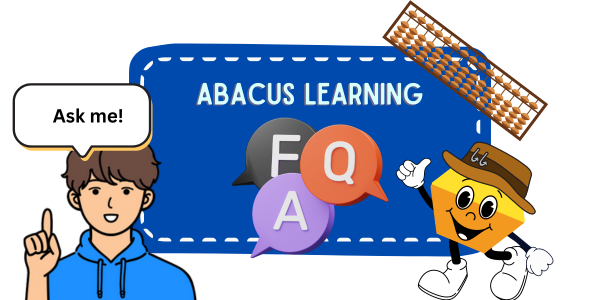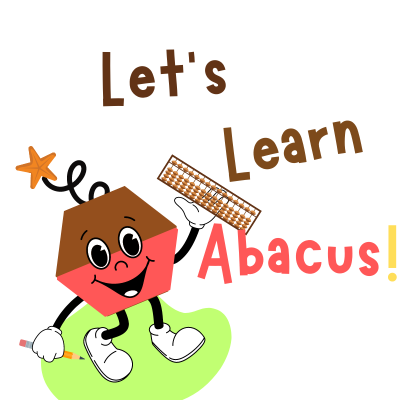
Essential Tips Before Beginning Your Abacus Journey
As an experienced abacus learner myself, I’ve compiled this comprehensive FAQs to address common questions and concerns that parents may have about learning abacus.
While I highly recommend abacus for young kids to develop early math skills, it’s important to know more about it first. Learning abacus takes time and commitment to become skilled.
Drawing from my own experience, insights from other learners, and feedback from parents, I aim to provide valuable information to help you make informed decisions about introducing your child to the world of abacus.
Please take a look at all the FAQs below to see if abacus is the right fit for your child. If you have any other questions that aren’t answered here, feel free to send me an email. Let’s find out if abacus is the right choice for your child’s learning journey!
ABACUS FAQs


Q. Can you provide more information about the purpose or content of this abacus tutorial website?
I launched this website because I wanted to help young kids get better at math using the abacus. My own journey with the abacus started in kindergarten, and it really helped me become great at arithmetic. While I shifted my focus to problem-solving and math competitions, my foundational abacus skills remained invaluable.
Looking back on my journey, I can see how learning the abacus not only improved my math skills but also gave me the confidence to excel in school. Research backs this up, showing that early math skills are very important for kids. What they learn in those early years can stick with them and help them succeed later on. So why not give kids the gift of abacus? They’ll improve their arithmetic and math abilities, and those skills will stick with them for a long time.
In Japan, abacus learning is a norm in elementary school. They have abacus schools available locally, so there are lots of chances for them to pick up these skills. However, in the United States, abacus education is less common. Even when available, formal classes or effective lessons can be pricey and difficult to access.
Based on my own experience and what others have shared, the abacus is like magic for kids. Sure, it has its own set of rules and tricks, but it’s not as difficult as it seems. I get how tough it can be for learners sometimes, but trust me, mastering the abacus can really boost your math skills. It’s like having a secret weapon up your sleeve for math success.
This website aims to make abacus learning accessible to all children. Currently covering addition and subtraction (as of May, 2024), I plan to introduce multiplication and division by fall 2024. I hope more people discover the power of abacus and start learning, paving the way for academic success.

Q. What is the best age to start to learn abacus?
I started learning abacus when I entered kindergarten ( 5 years and 10 months old). My little brother started learning abacus when he was 4 years old. I see many children start learning abacus around 5, 6 and 7 years old.

Q. What method do you use in your lessons?
In my lessons, I incorporate the Japanese abacus method, a technique I learned from my certified abacus teacher associated with a Japanese abacus organization. This method is widely used in Japan and is even featured in Japanese elementary school textbooks. While finger movement rules may vary among different abacus organizations or schools, standardizing them helps ensure quicker and more effective calculations.

Q. What kind of abacus should I get for your lessons?
There are several different types of abacus available. Please make sure to buy a Japanese style abacus for this lessons.
- Japanese style abacus – 1 upper bead and 4 lower beads, at least 13 columns. There are many different types of abacus sold at Amazon, but avoid the vintage-style or colored beads abacus. “Tomoe” is a well-established brand in Japan, recognized for its quality (wooden beads). However, it comes with a higher price tag compared to other brands in the market.
The plastic beads are acceptable for beginners, but they feel lighter than birch beads, which may result in manipulation being less smooth at times. You will need larger (23 columns) abacus to calculate more complex calculations such as multiplications and divisions. I would recommend 23-column, birch beads, with one-touch reset button as you advance.
* For Beginners *
13-17-column, plastic beads, any -maker is fine but make sure you buy a Japanese type (1 upper bead and 4 lower beads). This compact plastic abacus is ideal for learners unsure about committing to abacus studies. It’s a cost-effective option for testing a child’s interest. However, the price difference between this small plastic version and a larger one with plastic beads is minimal.
*Best Choice *
23-column, birch beads, Japanese maker (Tomoe, Unshudo, or others), reset button. This abacus model is ideal for intermediate to advanced learners.
*Good Choice *
23-column, birch beads, Japanese maker (Tomoe, Unshudo, or others). This abacus is suitable for everyone, though it requires manual resetting during calculations. For those interested in abacus competitions and seeking speed, an abacus with a reset button is more advantageous.

Q. What do I need to have in order to participate in your lessons?
The following items are needed in my lessons.
- Japanese style abacus
- Access to internet to see to the lessons.
- Printer to print out the worksheets to practice.

Q.What do you mean by parental support is essential for learning abacus?
I sincerely think that the involvement and encouragement of parents play a crucial role in a child’s success with abacus learning. Here’s why I think parental support is considered vital:
Motivation: For young kids, finding the joy in learning abacus can be tough initially (but it grows as they acquire more skills). Mastering abacus skills requires time and patience, which can be difficult for little learners to stay enthusiastic about. This is where parents step in! By offering encouragement and rewards similar to how teachers use stickers or small toys, parents can keep their kids inspired and supported during their abacus practice journey.
Practice: Learning abacus involves consistent practice. Parents can help create a routine and set aside time for regular practice sessions, ensuring that the child reinforces their skills consistently.
Assistance with Challenges: When children encounter challenges and require immediate feedback, you can guide them to access our video lessons or learn alongside them. That’s why I recommend parents to also take abacus lessons. Not only my mother but also other parents I’ve observed providing feedback to their children, despite having no prior abacus learning experience. They inquire with the teacher about specific parts they find challenging and then demonstrate the technique to assist their child. Feel free to send me your questions, and I’ll be happy to answer them. Kindly use this platform for any inquiries.
Celebrating Achievements: Recognizing and celebrating the child’s achievements, no matter how small, contributes to a positive learning experience. Parents can acknowledge and celebrate milestones, boosting the child’s confidence and motivation.

Q. Are there any drawbacks of learning abacus?
While learning the abacus offers numerous benefits, it’s essential to consider potential drawbacks. These can include:
Time Commitment:
- Learning abacus requires consistent practice and dedication. Some learners may find it challenging to allocate sufficient time regularly.
Initial Difficulty:
- Beginners may find the initial stages challenging, as adapting to a new counting system and finger movements can take time.
Dependency on External Factors:
- Young learners may rely on external motivation or rewards, making intrinsic motivation development a gradual process.
Focus on Arithmetic Skills in Math: While abacus training is highly effective for developing foundational arithmetic skills, mental math, and basic numerical operations, it may not directly contribute to more advanced mathematical concepts beyond the elementary level. It’s important to also explore other areas like geometry and advanced concepts that the abacus doesn’t cover. This means understanding shapes and spaces through learning about geometry. Origami is a great tool for helping young children develop an understanding of geometry and spatial awareness. As an origami master, I plan to release video tutorials on origami by summer 2024. Stay tuned for more updates!
It’s important to note that these drawbacks can vary among individuals, and many overcome challenges with consistent practice and support.

Q. What qualifications should I look for in an abacus instructor or program?
My abacus teacher holds a 6-dan certificate (with the highest level being 10 dan). I have achieved a 6 dan in Abacus, 9 dan in Mental Math, and 9 dan in Computer Mental.
Although I am still young and cannot apply for an official abacus instructor position, I possess sufficient knowledge and skills to teach abacus to everyone. Given that my instructor is affiliated with one of the recognized organizations in Japan and holds official certification, my achievements can be included in an official resume in Japan.
Over the years, I have secured victories in numerous abacus and mental math competitions. I believe it’s essential for an instructor to possess a dan-level certificate to deliver effective and proficient instruction. As you progress and aspire to reach higher levels or participate in competitions, I can recommend advanced abacus classes to help you further enhance your skills.

Q. What will my child be expected to learn from your lessons?
Your child will acquire essential finger movements for abacus additions and subtractions involving multiple digits. They will grasp rules and effective methods for abacus calculations, employing techniques widely used in Japan. Multiplications and divisions will be introduced in the near future. Please stand by.

Did you find the information on abacus learning helpful?
Feel free to reach out to me via email using the contact page for any questions you may have.
I’m here to assist you every step of the way! If you’re ready to start your abacus journey, please go to the Abacus Lesson Menu.
